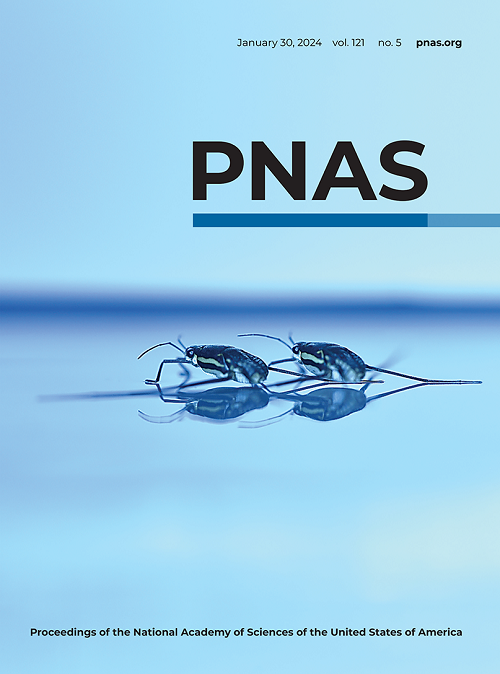Functional redundancy in the toxic pathway of Bt protein Cry1Ab, but not Cry1Fa, against the Asian corn borer.
IF 9.4
1区 综合性期刊
Q1 MULTIDISCIPLINARY SCIENCES
Proceedings of the National Academy of Sciences of the United States of America
Pub Date : 2025-04-17
DOI:10.1073/pnas.2503674122
引用次数: 0
Abstract
Crops genetically engineered to produce insecticidal proteins from the bacterium Bacillus thuringiensis (Bt) have been used extensively to control some major crop pests, but their benefits decrease when pests evolve resistance. Better understanding of the genetic basis of resistance is needed to effectively monitor, manage, and counter pest resistance to Bt crops. Resistance to Bt proteins in at least 11 species of Lepidoptera, including many important crop pests, is associated with naturally occurring mutations that disrupt one or more of three larval midgut proteins: cadherin and ATP-binding cassette proteins ABCC2 and ABCC3. Here, we determined how CRISPR/Cas9-mediated mutations disrupting cadherin, ABCC2, and ABCC3 singly and in pairs affect resistance to Bt proteins Cry1Ab and Cry1Fa in the Asian corn borer (Ostrinia furnacalis), which is the most damaging pest of corn in Asia and is closely related to the European corn borer (Ostrinia nubilalis), a major pest in Europe and North America. The results from bioassays of six knockout strains and their parent susceptible strain support a model in which Cry1Ab can kill larvae via one path requiring ABCC2 or another path requiring cadherin and ABCC3, whereas Cry1Fa uses only the first path. The model's predictions are generally supported by results from genetic linkage analyses and responses to Cry1Ab and Cry1Fa of Sf9 cells and Xenopus oocytes modified to produce cadherin, ABCC2, and ABCC3 singly or in pairs. The functional redundancy identified here for Cry1Ab could sustain its efficacy against O. furnacalis and may exemplify a widespread natural strategy for delaying resistance.抗亚洲玉米螟虫的Bt蛋白Cry1Ab毒性途径中的功能冗余,而不是Cry1Fa。
从苏云金芽孢杆菌(Bt)中产生杀虫蛋白的转基因作物已被广泛用于控制一些主要的作物害虫,但当害虫进化出抗性时,它们的效益就会降低。为了有效地监测、管理和对抗害虫对Bt作物的抗性,需要更好地了解抗性的遗传基础。至少11种鳞翅目昆虫(包括许多重要的作物害虫)对Bt蛋白的抗性与自然发生的突变有关,这些突变破坏了三种幼虫中肠蛋白中的一种或多种:钙粘蛋白和atp结合盒蛋白ABCC2和ABCC3。在这里,我们确定了CRISPR/ cas9介导的突变如何破坏钙粘蛋白、ABCC2和ABCC3单独或配对影响亚洲玉米螟(Ostrinia furnacalis)对Bt蛋白Cry1Ab和Cry1Fa的抗性,亚洲玉米螟是亚洲玉米最具破坏性的害虫,与欧洲玉米螟(Ostrinia nubilalis)密切相关,后者是欧洲和北美的主要害虫。6个基因敲除菌株及其亲本易感菌株的生物测定结果支持一个模型,即Cry1Ab可以通过一种需要ABCC2的途径或另一种需要钙粘蛋白和ABCC3的途径杀死幼虫,而Cry1Fa只使用第一种途径。该模型的预测通常得到遗传连锁分析结果的支持,以及Sf9细胞和爪蟾卵母细胞对Cry1Ab和Cry1Fa的反应,这些卵母细胞可以单独或成对地产生钙粘蛋白、ABCC2和ABCC3。在这里发现的Cry1Ab的功能冗余可以维持其对稻瘟弧菌的有效性,并且可能是延迟抗性的一种广泛的自然策略的例证。
本文章由计算机程序翻译,如有差异,请以英文原文为准。
求助全文
约1分钟内获得全文
求助全文
来源期刊
CiteScore
19.00
自引率
0.90%
发文量
3575
审稿时长
2.5 months
期刊介绍:
The Proceedings of the National Academy of Sciences (PNAS), a peer-reviewed journal of the National Academy of Sciences (NAS), serves as an authoritative source for high-impact, original research across the biological, physical, and social sciences. With a global scope, the journal welcomes submissions from researchers worldwide, making it an inclusive platform for advancing scientific knowledge.

 求助内容:
求助内容: 应助结果提醒方式:
应助结果提醒方式:


